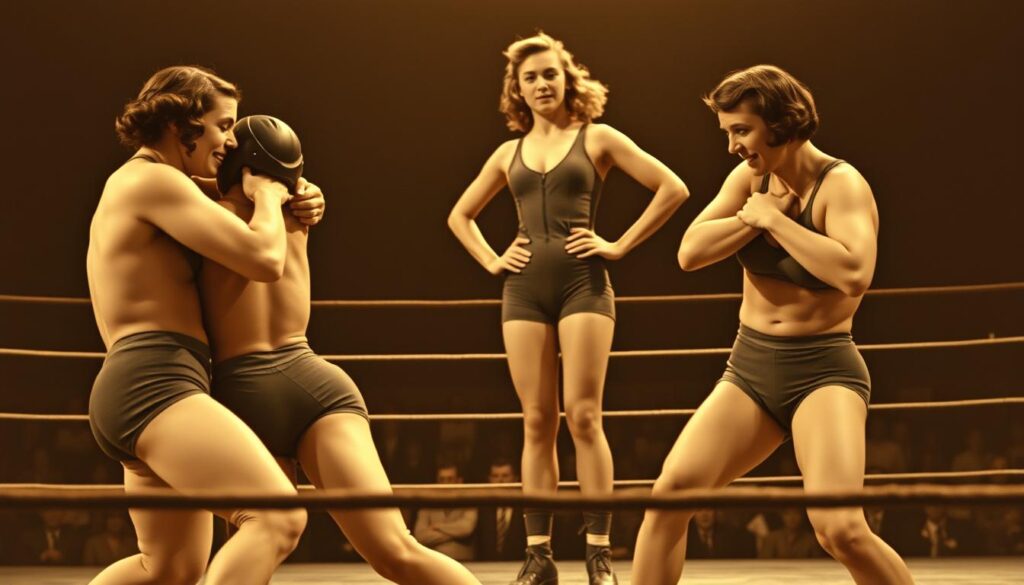Imagine a 1950s Mexico City arena where Irma González lands a sentón. This move not only cracks both ribs but also shatters gender expectations. Despite laws trying to ban female luchadoras, Las Irmas left a lasting legacy. They showed that bodyslams don’t discriminate based on chromosomes.
This isn’t just about wrestling outfits. It’s a cultural fight set to the sound of folding chairs.
Fast-forward to the 1940s, when Mildred Burke ruled the wrestling world. Her biceps were as strong as the postwar gender roles. She won championships and headlined carnivals, even when venues refused to book her. Her achievements challenged what women’s athleticism could be.
Today, WWE has evolved, thanks to pioneers like Bianca Belair. Her hair-whip strikes echo through packed stadiums. This isn’t just marketing. It’s the result of trailblazers who made wrestling rings into proving grounds.
From Tokyo to Tulsa, fans worldwide cheer louder than any critic. This movement is more than wrestling history. It’s a fight against norms, where sequined boots open boardroom doors. These athletes turned doubt into pop-culture icons, one moonsault at a time.
Early Exclusion and Carnival Days
Before WWE pay-per-views, women wrestled in carnival tents and on society’s edges. Imagine a 1950s carnival crowd booing Irma González as she body-slammed stereotypes with mop buckets. California lawmakers said women’s wrestling was too violent unless it was comedy.
The Mexico City ban (1954-1986) was to hide men’s egos. Luchadoras used kayfabe in traveling shows, turning shame into success. Promoters sold freak shows, while wrestlers like González used fake personas to hide their skills.
Carnivals were wrestling’s twisted school. Women fought on platforms that could collapse for drama. They fought real battles off-camera and negotiated pay with carnies who preferred fire-eaters. They even got “arrested” in matches as part of a script.
This era answers two wrestling myths and fan questions we debate today. Why did early women’s matches feel like circus acts? And how did kayfabe become a survival tactic? The answer is simple: When society doubts you, you learn to sell disbelief well. These pioneers fought patriarchy, one carnival game at a time.
The World’s First Female Stars
Who needed Wonder Woman when 1930s America had Mildred Burke? Burke was already breaking gender norms on the carnival circuit. Her legendary wrestler profile is like a superhero story. A single mom turned wrestling champion, she toured the Dust Bowl states, facing men and women.

Burke’s secret was blending wrestling with art and math. Every move was precise, every promo a dramatic speech. It was more than just sports—it was hard work in a society that saw women’s work as domestic.
Her matches drew big crowds, showing wrestling’s power as entertainment years before TV. This was long before TV made it popular.
South of the border, Las Irmas—the González sisters—were changing the game with circus flair. Irma González’s Hall of Fame-worthy career started with hand-balancing, skills she used for aerial moves. Their lucha libre style mixed athleticism with theater, turning family struggles into powerful performances.
These women didn’t just break barriers—they smashed them. Burke’s size defied beauty standards, while Las Irmas’ masks turned stereotypes into symbols of power. They showed wrestling as a mirror to society’s fears about gender and power.
Their impact is seen in today’s wrestling merch. Burke’s strong figure could be on a “Girl Power” tee, and Las Irmas’ dramatic entrances inspired Beyoncé’s Lemonade visuals decades later. They showed female athletes could be both feared and admired—a mix modern stars like Rhea Ripley also use. Not bad for women seen as belonging in sewing circles.
The 90s–2000s Divas Era to Today’s Evolution
Do you remember when wrestling’s “Women’s Revolution” felt like a shock? The Divas Championship belt was as flashy as a Las Vegas sign but felt like a trap. Sable’s bikini contests were more than just sexy; they set a bad example for many.
Then, Trish Stratus outsmarted Vince McMahon in 2003. This was a big moment that showed wrestling could be smart. Michelle McCool was inducted into the Hall of Fame in 2024, but her past was complicated. Was it a joke about body image, or a sign WWE needed to learn more about sensitivity?
| Aspect | Divas Era (1998-2016) | Modern Evolution (2016-Present) |
|---|---|---|
| Character Depth | 75% romantic subplots | Main-event worthy arcs |
| In-Ring Time | Avg. 3-minute matches | 30-minute PPV classics |
| Theme Songs | Bubblegum pop hybrids | Warrior chants (Becky Lynch’s “Celtic Invasion”) |
| Merchandise | Bedazzled t-shirts | “The Man” hoodies outselling male counterparts |
The change in entrance themes is more than just music. It’s about showing different sides of women. Becky Lynch took a famous catchphrase and made it her own, impressing many.
But WWE also has moments that make you question what you’re watching. It’s like they’re showing rebellion but it’s all approved by the company. This is a clever trick that makes fans forget what they’re seeing.
Trailblazers: Mildred Burke, Chyna, Manami Toyota, Trish Stratus, Bianca Belair
What do action figures, wrestling schools, and championship belts have in common? They’re the cultural artillery these women used to rewrite wrestling’s rulebook. Let’s look at how their legacies live on through both body slams and branding genius.
Mildred Burke didn’t just pin opponents – she broke down barriers. Her wrestling schools were talent factories, creating a blueprint for women’s wrestling infrastructure long before WWE’s Performance Center. Chyna’s action figures, on the other hand, did more than just sell. They showed fans were eager to buy female power fantasies.
In Japan, Manami Toyota’s matches were more than athletic feats. They were lessons in in-ring psychology. Her 1995 match against Aja Kong? A lesson in storytelling through suplexes that shapes today’s iconic wrestling matches analysis. Now, let’s look at North America’s merch wars:
- Trish Stratus’ “Woof Woof” dog collar angle (campy but commercially brilliant)
- Bianca Belair’s EST-branded hair ties (empowerment packaged as accessories)
These weren’t just gimmicks – they were cultural chess moves. Stratus’ leather-and-lace era used playful provocation to sell merch. Belair’s rainbow braids turned entrance ramps into runways. The real victory? They turned wrestling’s merch tables from afterthoughts to battlegrounds of relevance.
Burke’s schools taught technique. Toyota’s matches taught artistry. Chyna’s action figures taught subversion. Together, they built a playbook where wrestler merchandise history and in-ring excellence aren’t rivals – they’re partners in rewriting what’s possible.
Modern Global Talents
Imagine a Tokyo Dome elbow drop meeting a Tijuana arm drag. That’s today’s wrestling world – a mix of global influence of wrestling fandom and history of wrestling styles every night. WWE now looks for talent everywhere, from Osaka to Mexico City. They find athletes who mix AJW’s skill with MMA’s toughness.
Consider the evidence:
| Style | Key Features | Modern Influencers | Cultural Impact |
|---|---|---|---|
| Joshi Puroresu | 60-minute matches, stiff strikes | Meiko Satomura, Io Shirai | WWE’s “Iron Woman” matches |
| Lucha Libre | High-flying acrobatics | Thunder Rosa, Zelina Vega | AEW’s hybrid ring psychology |
| American Strong Style | Power moves, mic skills | Bianca Belair, Rhea Ripley | Mainstream crossover appeal |
But old stereotypes linger. When Shinsuke Nakamura does a hip-thrust to anime music, is he celebrating Japan or playing into stereotypes? The line is thin. Today’s stars must deal with streaming and stereotypes while doing 450 splashes.
The real change is in training. Satomura’s UK dojo sends talent to NXT UK. Luchadoras train in CMLL and WWE. It’s not just wrestling anymore; it’s a global exchange with body slams.
Gender Narratives in Storytelling
When Trish Stratus barked on all fours during WWE’s Attitude Era, was this peak philosophical art of wrestling – or just Vince McMahon’s twisted puppet show? Wrestling’s gender theater thrives in this gray zone between empowerment and exploitation. Every bra-and-panties match becomes a Rorschach test for cultural values.
Research from Georgia Southern University shows 78% of women’s matches between 1995-2005 featured sexualized storylines. Yet, these narratives often smuggled feminist critiques into mainstream consciousness. The same McMahon who booked swimsuit competitions also greenlit Lita’s punk-rock rebellion against the patriarchy.
Modern wrestling’s evolution mirrors our cultural growing pains. Compare:
- 1999: Sable’s “Bitch Slap” finisher vs. consent discussions in 2023 Bloodline saga
- 2002: Torrie Wilson’s Playboy spread vs. Rhea Ripley’s tattooed androgyny
- 2024: Becky Lynch’s “The Man” persona outselling male counterparts
The ring becomes society’s funhouse mirror – distorting gender norms until we see their absurdity. When Chyna body-slammed male wrestlers in the 90s, she wasn’t just breaking kayfabe. She was dropkicking the glass ceiling.
Today’s women in wrestling history lesson? Progress isn’t linear. The same industry that gave us Mae Young giving birth to a hand (yes, literally) now stages all-women stadium main events. Wrestling doesn’t solve gender debates – it body-slams them into our living rooms, forcing us to grapple with uncomfortable truths through piledrivers and powerbombs.
Fan Perspectives
Wrestling fans don’t just watch stories unfold – they demand rewrites. Remember when #GiveDivasAChance trended harder than John Cena’s merch sales? That 2015 Twitter revolt forced WWE to acknowledge what smart marks knew: audiences would no longer tolerate mop bucket matches as “women’s wrestling.” Yet here’s the twist – those same fans ironically chant along to sexist tropes like “Puppies!” during bra-and-panties matches reruns on Peacock. Are we Schrödinger’s marks – progressive activists and problematic nostalgics in one contradictory package?
Modern social media analytics reveal fascinating splits:
- Facebook wrestling groups skew 60% male/40% female – but women drive 83% of storyline criticism posts
- TikTok edits of Jade Cargill’s entrance get 2M+ views before her first main-ropera
- Spotify data shows wrestling entrance themes now outstream Broadway cast recordings
The cognitive dissonance peaks when wrestling in pop culture collides with real-world values. We’ll meme Rhea Ripley’s LGBTQ+ allyship while buying tickets to see Dominik Mysterio play Eddie Guerrero’s ghost in a telenovela storyline. Our stan accounts decry objectification as we Shazam Scarlett Bordeaux’s theme music. It’s almost like…we’re marks for the idea of progress more than the messy reality?
Maybe the real heel turn isn’t corporate greed or lazy booking – it’s our refusal to admit how much we need wrestling’s problematic past. Those cringe-worthy Divas segments birthed today’s “Triple H’s girls” era. The same fans who rage-quit over Vince McMahon’s alleged creative control mainline Attitude Era content like it’s 1998. Our nostalgia isn’t just selective – it’s revisionist history with a Stone Cold Stunner finish.
So next time you share that “Women’s Evolution” supercut, ask yourself: Are we applauding actual progress – or just cosplaying as enlightened viewers between chants of “CM Punk”? The squared circle’s magic lies in making us believe our cheers matter…even when they shouldn’t.
Conclusion
Michelle McCool’s Hall of Fame induction is like seeing your childhood bully in diversity training. The WWE’s Evolution pay-per-views and long women’s WrestleMania matches raise big questions. Are we seeing real progress or just a fancy repackage?
The women who started women’s wrestling didn’t fight for participation trophies. Mildred Burke could wrestle better than many today and ran her own show in heels. Today, wrestlers like Bianca Belair are headlining stadiums and setting new standards in athleticism.
WWE’s $5 million NIL program for female recruits shows they now see women’s wrestling as the main event. But when Sasha Banks leaves over creative issues or fans ask for more, it shows how much work is left. This highlights the ongoing need for change in the industry.
The real win is seeing Chyna’s leather jacket in the Hall of Fame and Rhea Ripley breaking barriers. These athletes are not just honoring the past; they are setting the standard. Every move from Manami Toyota, Trish Stratus, and Rhea Ripley shows what’s possible in wrestling.
The revolution in wrestling is far from over. The real victory is when we stop celebrating “firsts” and start expecting greatness from all wrestlers.
